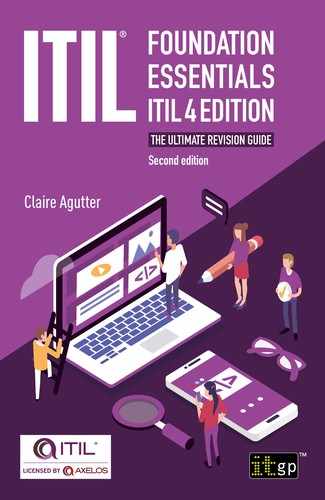CHAPTER 8: THE SERVICE VALUE CHAIN
The value chain is the central element of the Service Value System. It is an operating model that outlines the key activities required to respond to demand and facilitate value through products and services. The activities in the value chain are:
•Plan
•Improve
•Engage
•Design and transition
•Obtain/build
•Deliver and support
Figure 8 shows the service value chain.7
Figure 8: The ITIL service value chain
Activities in the chain don’t necessarily happen in a linear flow. Activities may happen in parallel, be repeated, or occur as a series of iterations. Different products, services and consumers will lead to different streams of work and different routes through the value chain. For example, developing a new application will be different from amending an existing one. These are an organisation’s value streams: combinations of practices and value chain activities that lead to value.
Each value chain activity relies on inputs and creates outputs for other activities. The activities are all interconnected. Skipping an activity, or spending less time on it than is needed, will impact the whole value chain as other activities will not get the inputs they need.
There are some key points to remember about the service value chain activities:
•All interactions with parties external to the service provider are performed via ENGAGE.
•All new resources are obtained through OBTAIN/BUILD.
•All planning takes place in the PLAN activity.
•Component, product and service creation, modification, delivery, maintenance and support is performed in an integrated way by the DESIGN AND TRANSITION, OBTAIN/BUILD, and DELIVERY AND SUPPORT activities.
•Products and services, demand and value are SVS components, not value chain activities.
Activity: Plan
“The purpose of the plan value chain activity is to ensure a shared understanding of the vision, current status, and improvement direction for all four dimensions and all products and services across the organization.”
Information inputs into the PLAN activity are used to create key outputs including improvement opportunities (for IMPROVE) and contract agreements (for ENGAGE).
Activity: Improve
“The purpose of the improve value chain activity is to ensure continual improvement of products, services and practices across all value chain activities and the four dimensions of service management.”
DELIVER AND SUPPORT provide service performance information and ENGAGE provides information about service elements provided externally. Outputs include improvement initiatives, status reports and service performance information for DESIGN AND TRANSITION.
Activity: Engage
“The purpose of the engage value chain activity is to provide a good understanding of stakeholder needs, transparency, and continual engagement and good relationships with all stakeholders.”
ENGAGE provides oversight of requests and feedback from customers, as well as incidents to help identify IMPROVE opportunities.
Activity: Design and transition
“The purpose of the design and transition value chain activity is to ensure that products and services continually meet stakeholder expectations for quality, costs and time to market.”
This activity receives portfolio decisions as an input, as well as information about components provided by suppliers from ENGAGE. This activity will create (among other outputs) requirements and specifications that are passed to OBTAIN/BUILD and contract requirements that are passed to ENGAGE.
Activity: Obtain/build
“The purpose of the obtain/build value chain activity is to ensure that service components are available when and where they are needed and meet agreed specifications.”
Organisations need to decide whether to create products and services themselves, or to use external resources, or a combination.
Activity: Deliver and support
“The purpose of the deliver and support value chain activity is to ensure that services are delivered and supported according to agreed specifications and stakeholders’ expectations.”
This activity will receive new or updated services, including service components from OBTAIN/BUILD and user support tasks from IMPROVE. The outputs will include the new or updated service being offered to users.
7 ITIL Foundation, ITIL 4 edition, figure 4.2.

